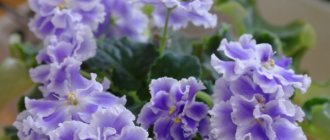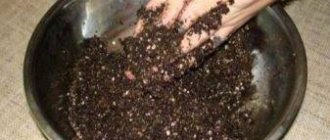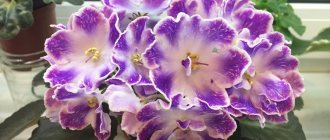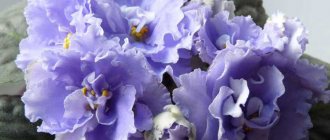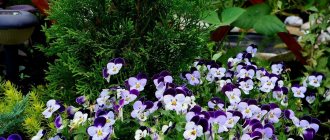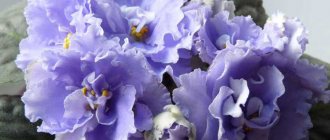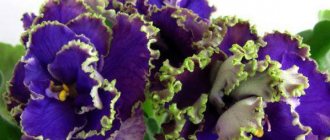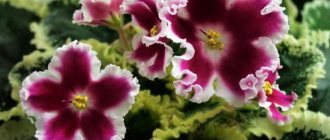Violets are common ornamental plants that are grown mainly indoors.
A wide selection of shades and varieties of this crop allows you to create a mini-flower bed at home. Dear readers!
For you, we have created communities on social networks in which useful articles and interesting ideas are published several times a day! Subscribe and receive useful content in a convenient format! A very popular type of violet is “Blue Fog”. The variety is distinguished by double, simple and fringed flowers.
Pests and diseases
Orchids need fresh air; care must be taken to ensure that the room in which they are located has minimal daily ventilation, but is not exposed to cold winter air.
Affected leaves
Air renewal is necessary in order to avoid the appearance of certain types of diseases, mainly caused by fungi.
Attention! High concentrations of moisture combined with high temperatures and polluted air provide ideal soil for the proliferation of fungi, bacteria and viruses. The most common pests are snails and slugs, especially if orchids are in the garden. If any symptoms of diseases are noticeable, it is recommended to contact a specialist garden center, where experts in the field can help and recommend remedies.
If any symptoms of diseases are noticeable, it is recommended to contact a specialist garden center, where experts in the field can help and recommend remedies.
The most common pests are snails and slugs, especially if orchids are in the garden. If any symptoms of disease are noticeable, it is recommended to contact a specialist garden center, where experts in the field can help and recommend remedies.
With proper care, a black orchid can bloom several times a year. In fact, Phalaenopsis orchids will adapt much better to indoor living than to outdoor conditions. And varieties with black flowers arouse constant interest among everyone.
Nuances when planting and growing, possible diseases
For the growth and good flowering of this plant, certain conditions must be met:
- The soil mixture for growing should be loose. Its composition: turf soil (3 parts), peat (5 parts) and sand (1 part). This soil mixture can be found in specialized stores.
- The soil should also be nutritious and moisture-absorbing with a slightly acidic pH of 5.5 - 6.5. You can improve store-bought soil by adding perlite. The addition of mineral chips improves the soil structure, making it lighter.
- The main requirement for growing violets is the ability of the soil to pass air. The root system of a plant needs a constant supply of oxygen to live.
- After about two months, it is time to fertilize, since the nutrient reserves of the soil are drying up by that time. Fertilizers vary in purpose. Nitrogen fertilizers are used to grow rosettes, while potassium fertilizers ensure the health of flower stalks. Concentrated complex mineral fertilizers can fully provide flowers with nutrition, because the elements in them are in an easy-to-digest form.
- You need to decide on the choice of container for the flower, its size and material. Suitable containers made of plastic and ceramics. A plastic pot is lightweight and durable, but it is not breathable. In a large container, the plant develops a root system without tending to flower. For the abundant appearance of flower stalks, a small pot is required. There should be holes at the bottom of the pot to drain excess water.
- For a comfortable existence, violets require a large amount of light, but not direct sunlight. Direct exposure to the sun results in yellow spots on the leaves. Pots with these flowers are placed on the east or southeast side; shelving is often used (in this case, the plant is illuminated with fluorescent lamps). The distance from the flower to the lamp should be 25 cm from the flower.
- A mature plant needs to be transplanted to a new location. Initially, containers with a diameter of about 4 - 5 cm are used, but when the violet grows, it becomes cramped. After six months, a container measuring 9 cm is needed. Young plants require replanting 2 times a year, in spring and autumn. Then the pot is changed once a year. If Saintpaulia is not replanted, salts accumulate in the soil, preventing the roots from feeding. During the transplantation process, diseased and dried leaves are removed.
- Three years after planting, violets lose their decorative qualities and the plant becomes more vulnerable to disease. By cutting and rooting the top part of the plant, it can be rejuvenated. The cut sites are treated with a special preparation.
Indoor violet can suffer from diseases and parasites. Among the enemies of violets:
- spider mite (the drugs Fitoverm and Actellik are used against it);
- whitefly (insecticides are used);
- mealybug (laundry soap);
- powdery mildew (fungicide);
- fusarium (treat the soil with a solution of copper sulfate).
We present to your attention an overview of the most popular and attractive varieties of violets: the striking “Chanson”, graceful “Cherry”, lushly blooming “Bronze Horseman” and “Isadora”, lovely “Fairy”, mysterious “Pansy”, lily-of-the-valley “Greenhouse effect” and exquisite varieties of the Optimara series.
Appearance: leaves, flowers
Violet leaves are like velvet. The shape can be ovoid, oval, round or with a heart-shaped base. Given the appearance, the outer part of the leaf takes on different colors, ranging from light to dark green. The inner part of the surface is light green or lilac, with pronounced veins.
The main feature of the Blue Fog variety is its light blue and light blue double flowers.
The edges of the petals are framed in white. The inflorescences of the heavenly shade are large in size. They have a spherical shape. Serrated leaves.
Peduncles are long and strong. Flowers rise above the leaves. There are 3 - 4 buds on one peduncle. When blooming in summer, the flowers are a richer shade of blue and may lack a white border. By winter, the color changes to that typical for this variety.
Photo
Next you can see the photo and description of the appearance of the violet “Blue Fog”
A short video review of the violet variety “Blue Fog”:
https://youtube.com/watch?v=s4uhEDjI-3A
Description of the variety
The Blue Fog violet was bred in 2001 by breeder Morev. This variety belongs to the standards, that is, its leaf rosette is of medium size.
The leaves of this Saintpaulia are dark green, round in shape with a wavy edge. The double flower is light blue in color with a white border; its appearance somewhat resembles a rather large lace star.
This variety, according to the description, has the following advantages:
- Unpretentiousness
- Abundant and long flowering
- Propagates quickly and easily
Violet Blue Mist, which was developed by K. Morev, is ideal for beginning gardeners.
Distinctive features of care
With careful care and properly selected soil, the plant blooms 10 months a year. At the same time, violets bloom profusely. Even young flowers develop a blue cap.
Rules for caring for violet “Blue Fog”:
- A constant temperature of 20 to 25°C is required.
There should be no draft in the room.
To avoid sunburn, the room must be shaded.
You also need to control humidity; any fluctuations of 50 - 60% of the norm can lead to illness. In a dry microclimate, flowers wither. You can purchase a mini-greenhouse.
Proper watering is important; for this, settled, unboiled water is used, slightly warmer than room temperature. Water with a thin stream, without splashing water on the leaves, no more than twice a week.
There are several factors that determine the timing of watering, these are the size of the pot, the time of year, the temperature and humidity of the room and the time of flowering. In spring - autumn, the plant needs to be moistened more often. Saintpaulia usually requires a portion of water every 3 to 4 days.
If there is a deficiency of nutrients in the soil, the flowers need to be fertilized. For this, liquid organic substances, thin sticks and tablets are used. When flowering, add fertilizer and repeat this procedure every season, if necessary.
How to “persuade” a plant to bloom again?
It's not easy, but it's possible. The main thing is that the plant completely retains its viability, it simply refuses to bloom. And if you fail to persuade this individual, then you can always do this by growing a new “optimark” from a cutting, full of strength and ready to give color. You need to start immediately after the plant enters your home.
- Treat the plant against insect pests.
- If necessary, if any, cut off the affected buds and leaves.
- Create a quarantine period for the plant by placing the pot in a warm place, eliminating any drafts and creating sufficient lighting.
- Spray and feed Saintpaulia for 30 days.
- Then transfer to another vessel.
- During replanting, it is necessary to carefully inspect the roots for rot. If damage to the root system is noticed, then all affected fragments are removed, and the cut areas are sprinkled with charcoal powder. You should also cut off all buds and flowers, remove yellow and blackened leaves. In this case, the central outlet must not be disturbed.
- If there are stepsons, you can cut them off and root them.
- After this, carry out the Saintpaulia care procedure as usual.
Optimaras do not always take root after transplantation, but if you devote time and effort to caring for them, then the chances of winning are great and after just four months they can give you a new cap of star-flowers.
How and when it blooms in natural conditions
Violet is often found in nature. Each species has its own flowering characteristics. The flowers vary slightly. To the untrained eye, it is quite difficult to distinguish them. If you study the peculiarities of coloring, it will not be difficult. The flowers have the following colors:
- Tricolor - the species got its name due to its color; the flower combines three colors at once: yellow, blue and white. The diameter of the inflorescence is 3 cm. Flowering occurs in May and lasts until September, the bush constantly forms new shoots and flowers;
- Dog - the petals are light blue or light purple, sometimes white, the diameter of the flower is 2-3 cm. It blooms in early May and ends in early July;
- Swamp - the color of the petals is soft purple, a distinctive feature is the presence of dark purple stripes on the lower petal. The diameter of the inflorescence is 3-4 cm. Flowering begins in May and ends by mid-summer;
Violet in a flowerbed
Important! To obtain abundant flowering, you need to create optimal growing conditions and provide proper care.
Violet SK-Landscape in the fog (A. Kuznetsov)
Fairytale violet SK-Landscape in the fog.
SK-Landscape in Fog is an indoor, miniature violet, from the genus of hybrid Saintpaulias, the Gesneriev family. The variety was bred by breeder A. Kuznetsov, named after the old 1988 film “Landscape in the Fog” directed by T. Angelopoulos.
The rosette is smooth, approximately 8-10 cm in diameter, and forms independently from a very early age. The lower leaves hug the pot as they grow, and then completely spin in different directions. The leaves are heart-shaped, velvety, rich green in color, on short stalks.
Flowering is abundant and long lasting. The flowers are bell-shaped, about 2 cm, white, have a blue center and blue-blue streaks along the petal, sometimes a darker color border appears.
Flowers bloom in a conveyor belt, falling leaves.
The variety is unpretentious and requires no more care than other miniature Saintpaulias.
Attention! Any variety can produce sport when propagated. This is unusual for SK-Peyzazh in Fog and happens so rarely that there is no accurate data about this process.
Pests
Violets, like any other indoor flowers, can be affected by pests and diseases. The most common pests found on Saintpaulias are:
Spider mites are dangerous and fast-spreading insects that feed on plant sap.
Violet that is not affected by pests (photo)
The main sign of its appearance is a white sticky coating on the surface of the leaves. To kill ticks you need to use special preparations. For example, “Fitoverm” or “Aktellik”. Other insecticides are ineffective against this pest.
Whitefly is a dangerous pest of greenhouse and indoor plants. Most often it appears when the air humidity is too low and the temperature is too high. To destroy it, it is best to use systemic insecticides that have the ability to accumulate in parts of the plant.
The mealybug is a sucking pest that feeds on plant sap. Violets infected with it are severely stunted in growth and die if left untreated. It is not difficult to destroy these pests. A solution of laundry soap helps in the fight against them.
Expert opinion
Yulia Yurievna
I have a large garden and vegetable garden, several greenhouses. I love modern methods of cultivating plants and mulching the soil, and I share my experience.
Since this is a very contagious insect, it is better to immediately isolate the affected specimen. To reduce the population, you can buy violets. This should be done carefully so that water does not leak into the pot. You need to hold the flower at an angle or cover the soil in the pot with film.
The drug Neoron can also be used for treatment. This remedy affects not only adults, but also their larvae, damaging the shell. Even when using such a strong drug, treatment alone is not enough.
In the fight against such pests, it is difficult to destroy the larvae. There are means that sterilize females of such ticks. Then it's easier to deal with them.
If mites are found on a flower window, you need to carry out preventive treatment for all other flowers, as well as disinfect their place of residence. It's even better to iron the curtains.
We would like to note that violets are sometimes affected by scale insects and false scale insects. Yellowish tubercles appear on infected leaves. Even one such pest is very dangerous; scale insects multiply quickly.
To begin with, spotted individuals are removed with a brush or cloth in alcohol or soap. Next, you need to treat with Actellik or Aktara.
While watching the video you will learn about the Blue Mist violet.
https://youtube.com/watch?v=vt7hBJvDPnU
Terry Saintpaulia variety Blue Fog is a beautiful and rather unpretentious indoor plant. Growing it at home is not at all difficult. Even a novice gardener can do this task.
Violets
Story
Violet: description (80+ photos), varieties, care and propagation at home + reviews
The history of the creation of Saintpaulia variety Blue Fog goes back a decade and a half (2001). This variety of blue indoor flowers was invented and bred by a young talented breeder Konstantin Morev. One of the provinces of East Africa can be considered its homeland; after its governor, the flowers were called “Saintpaulia”. Today, over two thousand species of these amazingly beautiful flowers have been registered on the planet, so it makes no sense to talk about them belonging to a separate geographical area. Flowers in the shade of the sky are endowed with a sacred meaning among many peoples, and blue violets have found their fans on all continents. And today, few people remember the name after whom they were named - Baron Walter von Saint-Paul. Today, Saintpaulia is one of the most common indoor plants, called the queen of flowers, not without reason.
How to register a new variety?
Nowadays, no one is involved in the registration of domestic varieties at the level of institutes or institutions of this type.
You can register the variety on some websites or try to do it through the Institute of Biology.
In the first option, registering a variety is free and takes little time. In government agencies, this process can last months and cost some investment.
In addition, you can register your varieties on foreign resources, but this is usually not free. For example, registration for AVSA is paid and this is not an indicator for most flower growers.
Popular articles Characteristics of black pine Oregon Green
If you do register a variety, then it is worth knowing the sequence of this process:
- After obtaining a new variety, it is fixed in at least three generations (when registering with government agencies, the procedure for fixing and checking can be carried out themselves, but in our time this is rare);
- Submitting an application for registration. On most sites, this requires at least two photos of the rosette (large flowering and the entire rosette) and a description of the parameters. All additional data will be requested if necessary. You can come up with a name right away, otherwise the variety will be assigned a number and then not all resources can change it to the name;
- Waiting for the result. After checking the similarity of the new variety to those already registered and the absence of strongly similar variants, the variety is assigned a number and name. The name is chosen either by the breeder himself when submitting an application, or with his permission, a competition is held and the best option is selected.
Pollination of parent plants
The main way to develop new varieties is pollination. To do this, select two parent varieties according to the parameters outlined above.
Then the long process of elimination begins:
timing of pollination - it is extremely important to carry out the pollination process on time: the mother flower (which is pollinated) should be no older than 3-4 days, the main indicator is the stickiness of the tip of the pistil; the father's flower, on the contrary, must be well-ripened, no younger than 3-4 days, depending on the duration of flowering of the variety.
Attention! Pollen can be used from dried flowers; the storage time of such material is about six months, this simplifies the selection process by eliminating the need for simultaneous flowering of the parent bushes.
When choosing a mother bush, it is important to carefully examine it or even prepare it in advance. The rosette must be healthy and strong enough for the seed pod to ripen on it
The paternal rosette can be anything, but a healthy rosette has a higher chance of successful pollination; those flower growers who do not risk taking dried pollen must first align the flowering cycles of the parent rosettes: to do this, the flower stalks are cut off on a bush that wants to bloom much earlier than the second; Another option is to remove several flower stalks from both bushes and move them to cool conditions, and then expose them to plenty of light and warmth, after which they usually bloom together.
After all the preparations, it’s time to pollinate the flower. For this:
cut off the anther from the father's flower;
break or cut it; holding the anther tightly with tweezers or picking it up with a needle, dip the stigma of the pistil inside the crack; pollen should remain on the sticky tip (a noticeable change in its color); some gardeners simply place the anther on the pistil for a better effect.
- A successfully pollinated flower shows this after a few days. A compaction appears under the pistil, which is the future seed pod;
- seeds ripen from 1.5 to 8 months, it all depends on the conditions and the mother plant. You need to wait until the box dries. It must be remembered that seeds that have matured longer have better germination, for example, 1.5-month-old seeds often do not germinate at all;
- After receiving the seeds, they are sown, preferably as soon as possible. Sowing is carried out in moist soil, without sprinkling with soil on top, covered with film and periodically sprayed, the temperature for germination is 22°C;
- The children are raised in a greenhouse for a long time, periodically ventilated. Picking is carried out 2-3 times, depending on the density of the seedlings;
- after transplanting into separate flowerpots, the care of the young plant coincides with the care that is provided to the planted baby, obtained by the vegetative method;
- During the growth process, “unnecessary seedlings” are culled. Those rosettes that, according to the parameters set by the breeder himself, do not pass and are not interesting to him, are simply thrown away or given away;
- The last step to obtain a new variety is to check the result or consolidate it. In order to be called a full-fledged variety, a flower must transmit varietal characteristics when propagated by leaves or stepsons from three generations or more. Until then, I consider the plant to be a seedling.
To obtain specific parameters, multiple pollination is often used, thus adding more and more new rosette and flower parameters. To do this, a suitable seedling after the first pollination is dusted during the second flowering or pollen is taken from it and mixed with a suitable variety.
The process is repeated until the desired result or varieties are obtained that interest the breeder more than his original plan. This procedure is very labor-intensive and such work may take years, but the reward will be the varieties bred at the intermediate stages and, most importantly, a new, unique, final variety.
Pollination of Saintpaulias is a very complex process, especially for indoor bred species. Their anthers grow together, which virtually eliminates both cross-dusting and self-dusting.
In rare cases, the coincidence of damage to the anther in some way and the presence of an insect or other method of transferring pollen leads to dust.
Self-pollinating violets at home is almost impossible.
Characteristics of species with photos
Tired Sun
Variety 2005. The rosette is large, with long petioles, and quite neat. The leaf is dark green, quilted. The flowers are large (up to 6 cm), from simple, in the first flowering, to heavily double.
The color of violet petals is salmon pink, with a darker spot in the center. The spot appears on the seventh day after the bud opens and gradually begins to grow. Depending on the conditions of detention, the central spot can completely fill the petals, but usually its spread ends 4-5 millimeters from the edge of the petal, creating the effect of a wide border.
Attention: The variety feels great without additional lighting. When propagating children from a leaf, it produces quickly, actively grows and gains green mass
Blooms seven months after planting
It blooms seven months after planting.
Stone Flower
Variety 2007. Standard socket. The leaves are large and wavy (some breeders write about severe leaf curling that occurs with excess light). The foliage is rich green.
The flowers are medium (up to 4 cm), semi-double and double. The color of the petals is ruby-violet, with darker tips, a white border and a greenish fringe. The violet bud blooms lighter, more monochromatic and darkens throughout the entire flowering period, the corner areas of the petals much faster.
By the end of flowering, some parts of the flower are almost black. The color of the fringe also becomes more saturated towards the end of flowering and stands out strongly against the background of the petals. The structure of the petals is dense, which allows them to better tolerate changes in air humidity. The bud opens completely in 3 weeks.
It produces flower stalks not at once, but gradually, so it is unlikely to get an abundant head of flowers.
When propagated by leaves, the violet produces babies reluctantly. It grows and develops very slowly to the size of a large starter. Then it begins to gain leaf mass more actively. An adult plant is unpretentious. It feels great on a windowsill with natural light and tolerates overflow and drought well.
apple blossom
It is not recognized as a variety by the breeder himself, but it has made an impression on many flower growers and is included in their collections.
The rosette is not very neat, but can be trained when the light changes. The petioles of the leaves are a little long. The foliage is lush green, edged with white.
The flowers are simple and semi-double, located on slender peduncles that cope well with a large number of buds. The color of the petals is soft pink. The flowering of Saintpaulia is very abundant and frequent, it blooms with a cap.
Does not like excessive lighting. Feels good on eastern window sills. When growing on a shelf, it is better to place it on the edge of the shelf.
Olesya
Seedling. The socket is neat and compact. The foliage is medium green and quilted. The flowers are quite large (up to 5 cm), very lush and elegant. The shape resembles a hemisphere. The color of the petals is unusual - bright neon pink with a darker eye and cherry speckled edges.
The plant produces a large number of flower stalks, each with 4-5 buds. Therefore, it blooms with an amazingly beautiful and lush head. Flowering is long lasting, can last more than 2 months. Sometimes you have to remove the flower stalks so that the rosette has time to gain green mass.
“Olesya”, when propagated by leaves, quickly produces babies. After transplantation, it grows and develops well, gaining green mass. An adult rosette is unpretentious and easily tolerates changes in light, temperature and humidity.
We recommend watching a video about K. Morev’s violet variety “Olesya”:
Summer night
Variety 2007. The rosette is large and loose. The leaves are lush green, slightly wavy.
The flowers are large (up to 6 cm), semi-double and double. The color of the petals is violet-blue with a white center and a white border around the edge. As it develops, “blurry effects” appear in the center of the petals. In bright light, the color of the petals fades slightly to a warm lilac.
Flowering is long, up to 2 months, but the plant produces flower stalks irregularly. The variety is sensitive to temperature changes. If the room was cool when the buds were planted, the flowers will be lighter, and sometimes almost white, with light blue prints.
“Summer Night”, when propagated by leaves, quickly produces babies. After transplantation, it grows and develops quickly. Sports happen, but not often. The variety does not tolerate flooding and excess light very well; in this case, the leaves become light green or turn yellow. In principle, it will feel good on the windowsill, without additional lighting.
Conditions of detention and care
Violet Frosty cherry is warm and light-loving.
It is possible to achieve the correct flowering and development of the plant, characteristic of the variety, only if the following conditions are met:
- Sufficient illumination. The violet reacts to a lack of light by stretching out the peduncles and turning the flowers pale. Violet needs bright but diffused light, so it is better to install it on east or west windows. The leaves should not be exposed to direct sunlight, which will cause burns. Excessive light causes clogging of the center of the socket, so in summer it is better to shade it even on eastern and western windows.
- Air temperature from 20 to 25 degrees. A decrease or increase in temperature will not destroy the violet, but will affect flowering. In the heat, the flowers will be small, and at temperatures below 16 degrees the violet will stop blooming altogether.
- In insufficient light, the flowers of the Frosty cherry violet turn pale.
Air humidity is not less than 40 and not more than 65%. Heat combined with high humidity affects the flowers: they become simple, without terry. The room where the violet is located must be ventilated daily. The lack of moisture is compensated by installing open containers with water next to the violet. Spraying the plant to replenish moisture deficiencies is contraindicated.
- Regular watering with soft water at room temperature. The plant should be watered only after the soil has dried to a third of its height. Overwatering leads to rotting of the root system, and the plant may die.
Organization of fertilizing
Overfeeding violet Frosty cherries is harmful. The variety does not like nutrient-rich and dense soils. Such compositions inhibit the plant and reduce the quantity and quality of flowers. The violet begins to hurt.
If the plant shows signs of depression and begins to lose its attractiveness, it is recommended to replant and replace the soil. The soil needs to be poor in nutrients and as light as possible.
Adult plants are fed once every 2-3 weeks with organic and mineral compounds. Organic matter is added during the formation of the rosette, mineral mixtures are added during flowering. The first feeding is carried out 30 days after transplantation.
Transfer schedule and rules
Frost cherry violet is replanted twice a year. In this case, the size of the pot is gradually increased as the roots of the rosette grow. The maximum diameter of a pot for an adult violet is 12-13 centimeters.
A complete replacement of the soil during replanting is done if there is a suspicion of the presence of a disease.
If the plant looks healthy, transplantation is carried out together with a clod of earth. The slightest signs of trouble are a reason to completely replace the soil
In this case, remove the violet from the pot, carefully shake off the old soil from the roots and place the plant in a new pot.
To grow violets, you need the lightest and loosest possible soil. Special soil for violets is ideal, but to increase looseness you need to add perlite or vermiculite, approximately 10% of the total volume.
If it is not possible to purchase ready-made soil. You can prepare the substrate for planting yourself. The basis of the mixture is leaf or turf soil. It needs to be added to the mixture of 5 parts.
Popular articles When boletus mushrooms begin to grow
Add 3 parts peat and 1 part sand to the prepared soil. Then mix everything with vermiculite or perlite (10% of the total volume). For disinfection, a small amount of wood ash and sphagnum moss is added to the mixture.
Growing conditions
Saintpaulia is not a demanding plant, but for successful growth and abundant flowering you still have to adhere to certain growing conditions.
Lighting
Violets prefer bright but diffuse lighting with protection from direct sunlight. Windows with eastern and western exposure are considered the best for them. To extend the flowering period in winter, they need lighting.
Temperature
The optimal temperature for growing Saintpaulias is 23-25°C. A temperature drop below 18° is detrimental for this crop. Violets also react negatively to cold drafts.
The soil
The soil for growing violets should be loose, nutritious and sufficiently moisture-absorbing.
You can prepare it from 3 parts of leaf soil, 5 peat and 1 river sand. If you don’t have the opportunity to make your own soil mixture, you can purchase ready-made soil for growing violets.
Watering
Proper watering is the key to successfully growing violets. Irrigation water must be settled and at room temperature. Watering with cold and hard water is unacceptable. It is best to water Saintpaulia through a tray, and excess water must be drained after this.
You can also moisten violets through top watering. In this case, you need to ensure that water does not get on the leaves or in the center of the rosette.
Attention! The leaf blades of violets are covered with tiny fibers and when in contact with water they rot very easily.
Distinctive features of care
With careful care and properly selected soil, the plant blooms 10 months a year. At the same time, violets bloom profusely. Even young flowers develop a blue cap.
Rules for caring for violet “Blue Fog”:
A constant temperature of 20 to 25°C is required.
There should be no draft in the room.
To avoid sunburn, the room must be shaded.
You also need to control humidity; any fluctuations of 50 - 60% of the norm can lead to illness. In a dry microclimate, flowers wither. You can purchase a mini-greenhouse.
Proper watering is important; for this, settled, unboiled water is used, slightly warmer than room temperature. Water with a thin stream, without splashing water on the leaves, no more than twice a week.
There are several factors that determine the timing of watering, these are the size of the pot, the time of year, the temperature and humidity of the room and the time of flowering. In spring - autumn, the plant needs to be moistened more often. Saintpaulia usually requires a portion of water every 3 to 4 days.
Features of flowering, growth and reproduction
The Blue Mist rosette grows quickly, maturing already at 11 months , the first flowering can occur by 8-10 months.
The variety is propagated by all available methods, and each has a large percentage of sports.
Depending on the temperature conditions, the color of the flowers may change .
In the heat, darkening of flowers is quite often observed, but after bringing the conditions back to normal, flowering returns to normal. In a cool room it may lighten a little, but not critical.
It blooms with a large cap, almost always. There are many buds, they rise to the center on strong, plump peduncles.
Important! Flowering occurs in waves at intervals of 2-3 months. Moreover, each bud lasts quite a long time, which ensures more abundant and lush flowering.
Soil preparation
To plant Saintpaulia seeds, you can use ready-made soil. You can also make your own flower nutrient mixture. The ready-made version can be purchased at any store specializing in indoor plants.
Here are several options for compositions that the gardener can make himself.
- You should mix the deciduous, peat, turf and coniferous components in a ratio of 3: 2: 1: 1. Then you need to add crushed sphagnum, vermiculite or, for example, perlite, for loosening. It is also advisable to use charcoal.
- You need to mix the coniferous and turf parts in a 1: 1 ratio. Then you should add peat and crushed sphagnum in the same quantities. You should also add a double dose of the leaf component and half of the sand (1: 1: 1: 1: 2: 0.5). It is useful to add coal as a sorbent, fertilizer (K, Ca, F), as well as an antibacterial composition.
- It is necessary to take garden soil from the garden bed where legumes were grown. Soil from mole holes is also suitable (it is the most granular). For 4 parts of land you need to take 1 part sand and 1 part black peat.
Each ingredient should be sifted and cleared of plant debris so that rotting does not interfere with the healthy growth and development of seedlings.
There are many recipes for soil for violets, but none is the only correct one. It all depends on the quality of the ingredients
It is important that the soil is not very greasy, loose, absorbs moisture well, but at the same time allows air to pass through so that the roots do not rot. You can use different ratios of parts to get your mixture experimentally
Before planting plants in the soil, it is necessary to disinfect it with heat or cold (steaming or freezing). You can also use a solution of foundationazole or another drug. To protect plants from infection with any diseases, you can sprinkle the seeds with fungicidal powder. This is especially necessary when using components obtained independently outside the city.
For example, the use of sphagnum in soil composition has a powerful antiseptic effect.
Reproduction
The easiest way to propagate violets is from leaf cuttings. To do this, you need to select a strong and healthy leaf from the second row from the bottom. The resulting cutting can be rooted in water. To do this, you need to take a dark container, pour boiled water into it and put an activated carbon tablet.
The sheet is placed in a container so that only its tip is immersed in water. After 10-15 days, roots will appear on it. After which it can be planted in the soil. If all conditions are met, babies will appear on it in a month and a month and a half.
Some gardeners prefer to root leaf violet cuttings in the ground. To do this, after cutting, they are planted in loose and nutritious soil. In this case, the petiole is buried into the soil no more than 1 cm. And so that the stalk becomes stable and does not fall, it is secured with a toothpick.
The leaf planted in this way is covered on top with a plastic bag or glass jar.
After a month, babies begin to appear at the base of the cuttings. After they grow up, they are planted in separate containers.
Caring for a plant at home
Blue Fog is a completely unpretentious variety, but to get a good rosette and abundant flowering you will have to follow the rules.
Place of cultivation
The variety feels great on the windowsill and under a lamp; it has no tendency to pull or droop the leaves. You just have to remember that direct rays of the sun leave burns.
Temperature greatly affects the color of flowers
If you create cooler conditions (it is important not to drop the temperature below +18°), the flowers will be lighter, sometimes almost white with a slight blue print, almost a dusting
When the temperature rises excessively (26°-28°), the flowers darken, there may be completely blue prints, with a blue edge, and sometimes the flowers turn completely blue. The optimal temperature range is considered to be from 22 to 24°.
Air humidity above 70% leads to rotting of the leaves and growing points, which leads to the death of the flower. Overdried air, up to 50%, leads to softening of the sheets and their wilting. It is recommended to maintain this indicator in the interval between the lower and upper acceptable limits.
Watering and fertilizing
Watering and fertilizing are carried out using two main methods:
- Add water to the tray (under the leaves) once a week - in summer and a little less often in winter. After watering, excess water is drained 20 minutes after the procedure. Fertilizers are applied periodically, approximately once every 2-3 weeks, depending on the season (through watering), and the dosage is halved;
- Wick - a cord is placed in a pot and brought out through a drainage hole, a container with water is placed under the flowerpot. There is always water in the container, and fertilizers are constantly there, and its concentration decreases by 7-8 times, relative to the instructions.
Replanting and pruning
For replanting, it is important to choose the soil; you can buy a ready-made mixture for Saintpaulia, or make it up from:
- Peat;
- Sheet soil and perlite with the addition of sphagnum moss;
- Or coconut fiber.
The proportion depends on the type of irrigation:
- For the first -1/1/1/0.5;
- For the second one 1/0/1/0.1.
Pruning is carried out regularly, removing dying parts of the rosette (leaves and peduncles, roots during transplantation). Planting material for propagation is also cut off - leaves of 2-3 rows, not completely faded peduncles and stepsons.
Popular articles Is it possible to eat overgrown champignons?
Transplantation is carried out for several reasons:
- To replace the pot - as the pot grows, the rosette with a lump of soil is transferred;
- As planned, to replace the soil - approximately once a year, without changing the flowerpot, the soil is replaced, and dead roots are removed;
- In case of illness, the transplant is carried out as in the previous case, but the flowerpot and plant are additionally processed.
Reproduction
This variety reproduces well by any convenient method:
- Leaf cuttings - leaves of the second and third row are rooted in soil, water or moss;
- Stepchildren - grown stepsons are separated and planted (provided they have their own roots), or rooted as leaf cuttings;
Violet is often propagated by leaf.
- Peduncles - not completely wilted peduncles are rooted in the soil under the film.
Important! The variety is very prone to sporting, and this factor does not depend on the type of propagation. It is important to leave a lot of children before flowering, so that later you can select varietals.
Care Tips
Experienced plant growers recommend adhering to the following care tips:
violets require special soil; they will not grow in ordinary garden compost; there is ready-made soil on the market that is ideal for them, but you can make it yourself by using one part each of sphagnum moss, perlite and loam; choose a container with drainage holes in the bottom; the container can be made of clay or plastic, but in the first case it is worth monitoring the soil for salting; place the violet on a window that faces north or east in summer, and south or west in winter; flowers require 10 to 16 hours of bright, indirect sunlight and 8 hours of complete darkness per day; if these requirements are not met, they will bloom; when watering, it is necessary to prevent moisture from getting on the leaves, otherwise mold or mildew may appear; even a drop can cause ugly spots; water for irrigation must be warm; Before each new watering, you should definitely check whether the soil is dry enough, since the flower does not like too waterlogged soil; The ambient temperature should be between 65 and 70 F; deviation is allowed, but not more than 15 degrees; it is necessary to remove plants from the window at night to prevent cooling, otherwise they will darken and dry out within 24 hours; it is important to maintain high humidity around the violets; you can fill a metal or plastic tray with water and small pebbles and place it nearby; fertilizing is a prerequisite for normal violet flowering; experts recommend using a balanced fertilizer designed for flowering indoor plants; fertilizing is applied once every 2 weeks with watering, the dose should be 4 times less than on the package; if you want the plant to constantly delight you with flowering, then it is recommended to additionally use artificial lighting.
To learn how to grow a violet from a leaf, watch the video below.
About the violet blue fog moreva: what the seeds look like, pollination at home
Violet is a decorative flower that is grown indoors. The Blue Fog Moreva variety is very popular among many gardeners due to its double flowers of a pleasant heavenly shade, easy care and simple propagation.
Features of violet care Blue fog Moreva at home
The plant is easy to care for, but in order for it to grow well and not get sick, certain conditions must be observed.
When and how does it bloom
Violet Frosty cherry - description and characteristics of the variety
With proper care, violets can bloom 10 months a year. The rosette begins to grow at 11 months.
This is an amazing plant, the shades of its flowers depend on the temperature. If you want to get a delicate, almost white inflorescence with a slight blue, the plant should be kept at a temperature no higher than 20 degrees. The warmer the room, the darker the violet blooms.
Inflorescence shapes
The plant always blooms with a large head. The emergence of buds is directed towards the center; they are supported on strong peduncles.
The Blue Fog variety is popular due to the fact that its flowering can be enjoyed for a long time. It happens in waves. Each bud lasts a long time.
Changes in care during the flowering period
If the violet blooms for a long time, it is necessary to improve the conditions for its maintenance.
It is important to provide good lighting at least 12 hours a day
The soil needs to be additionally fertilized, since flowering reduces the plant’s immunity.
Dried parts that have faded must be carefully removed.
Pollination technique at home
There are three ways you can pollinate a plant at home:
- entomophily (similar to the action of insects);
- wind technique;
- animal technology.
All methods are easy to use on your own.
Transplantation after purchase and during reproduction
Experienced gardeners recommend replanting violets immediately after purchase. To do this you need to prepare the right soil. You can buy it at a flower shop or make it yourself from peat, sphagnum moss with perlite and leaf soil. For propagation, leaves from the second or third row, as well as unfaded peduncles, are taken as planting material.
Plant replantation may be required in several cases:
- when the plant is actively growing, to increase the size of the pot;
- as planned to replace the soil - in this case, the procedure is carried out once a year.
It is also necessary to replant the plant if it begins to hurt. It is necessary to remove contaminated soil and dead parts of the flower.
Flower transplant
Possible problems in growing
Despite the fact that the flower is very unpretentious, if proper care is not provided, it can get sick, rot or dry out.
Problems with leaves
Often gardeners are faced with changes in platinum leaf. It may begin to rot and brown spots appear on the surface. The causes of leaf death are:
- lack or excess of lighting;
- improper watering;
- poor soil;
- lack of fertilizers.
Improper care leads to the fact that the plant’s immunity decreases. It becomes susceptible to diseases; a weak flower is most often attacked by pests. Leaves may droop and curl.
Attention! If the leaves lose their elasticity, this indicates that the roots have rotted.
Pests
A houseplant may suffer from pest attack. The most common are:
- Spider mites are a very dangerous insect that multiplies quickly. Its appearance can be detected by a sticky coating on the foliage.
- Whitefly is a parasite that appears due to low indoor humidity levels.
Plant growth stops completely if it is attacked by a mealybug. It sucks out the juice of the violet, leading to its complete death.
Pests need to be controlled with systemic insecticides.
Plant damage by spider mites
Diseases
The flower can become ill with a fungal pathology called powdery mildew. It appears as a white coating on the leaves. This is a dangerous disease that affects the roots and then spreads to the leaves.
As soon as the lesion is noticeable, you need to immediately remove it and treat the soil with a solution of copper sulfate.
Signs of improper care
If the flower does not have enough light, it is overwatered or, conversely, overdried, problems will be reflected on the leaves. They may develop dark spots, hang from the pot, or curl up.
If measures are not taken in a timely manner to improve the conditions of the plant, it will completely die.
With proper care, the magnificent Blue Mist violet variety will delight you with delicate flowers of a heavenly hue all year round.
Violet SM-Zephyr (Seedling Morev)
SM-Zephyr is one of the representatives of indoor Uzambor violets, which belong to the genus of hybrid Saintpaulias from the Gesneriev family. The seedling was bred and registered by Kostantin Morev, who has developed a few varieties, but they are all very beautiful. The breeder himself is very scrupulous about the concept of a variety, and therefore many of his offspring bear names with the notation “seedling”.
A rosette of standard type and size, which has rounded leaves, on elongated cuttings. The medium green color of the leaves, which depends on the light and temperature, may darken slightly or approach a light shade.
Delicate violet Zephyr.
Important! The shape of the sheets is very recognizable; they are quilted and have a kind of ruffle along the edge. This is a feature of this variety. The flower has the shape of a cupped star, most of them are simple flowers, but sometimes there are semi-double specimens
The color of the flowers is quite delicate, gentle and alluring, and also often incomprehensible. In the original, the main shade is white, and in the center of the petals there are pink prints in the form of strokes. But sensitivity to temperature and light conditions changes color from white with a slight pink tint to pure hot pink
The flower has the shape of a cupped star, most of them are single flowers, but sometimes there are semi-double specimens. The color of the flowers is quite delicate, gentle and alluring, and also often incomprehensible. In the original, the main shade is white, and in the center of the petals there are pink prints in the form of strokes. But sensitivity to temperature and light conditions changes color from white with a slight pink tint to pure hot pink.
SM-Zephyr has a sport that has curly leaves. There are various sports: photos and descriptions of which you can see on the Internet.
Replanting after purchase
If you purchased an adult plant or a baby plant, then they need to be replanted immediately, since the soil may be unsuitable. Choose a container that is approximately 2 times smaller than the outlet. If we are talking about children, you can take 50 ml plastic cups (for example, for children's cottage cheese).
Transplanting violets after purchase
You must make holes at the bottom. Next, expanded clay is poured in and covered with earth.
Note! The violet should be in the container at such a level that the midpoint of growth rises slightly. Place the rosette in the middle and carefully add soil to the sides. Lightly compact
Lightly compact.
